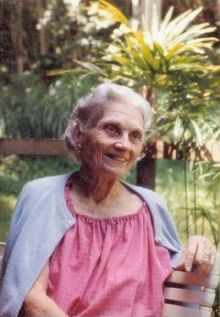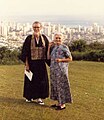Anne Hopkins Aitken
Anne Arundel Hopkins Aitken | |
|---|---|
 | |
| Personal | |
| Born | Anna Stinchfield Hopkins February 8, 1911 |
| Died | June 13, 1994 (aged 83) |
| Religion | Buddhism |
| Spouse | Robert Baker Aitken |
| Children | Thomas L. Aitken |
| School | Zen Buddhism |
| Education | Oxford University Scripps College Stanford University Northwestern University |
| Senior posting | |
| Teacher | Soen Nakagawa Hakuun Yasutani Yamada Koun |
| Based in | Diamond Sangha |
| Website | anne.robertaitken.net |
Anne Arundel Hopkins Aitken (February 8, 1911 – June 13, 1994) was an American Zen Buddhist, in the Harada-Yasutani lineage. She co-founded the Honolulu Diamond Sangha in 1959 together with her husband, Robert Baker Aitken.[1] She purchased both of its properties: the Koko An Zendo and Maui Zendo.[2] Honolulu Diamond Sangha has been considered "one of several pivotal Buddhist organizations critical to the development of Zen" in western countries.[3]: 23 Anne Aitken was also one of the original founders of the Buddhist Peace Fellowship.[4][5]
Early life
Anne Hopkins was born on February 8, 1911 to in Cook County, Illinois. Her mother, Marian Stinchfield Hopkins, was born in Detroit, Michigan, and was 25 when Anne was born. Her father, Lambert Arundel Hopkins, born in New Mexico, was a 29-year-old "railroad supply man" when she was born.[6][7][8]
Named Anna Stinchfield Hopkins on her birth certificate, No.6407, Anne told her husband, Robert Baker Aitken, that her name was later changed (when she was old enough to remember the event, perhaps six to eight years-old) because Stinchfield did not provide positive numerology readings.[9]
Education
Anne spent the years 1929 to 1931 studying abroad as an undergraduate at Oxford University and graduated from Scripps College in Claremont, California with a B.A. in English in 1932. She then pursued a master's degree in sociology, first at Stanford University in 1933, and later at Northwestern University (1940–1942). In addition to her Oxford years, she also lived in England from January to June, 1937. She traveled to Sweden, Finland, France, Germany, Spain, Japan, Italy, México, and much of South America[10] Among other experiences, she had worked in a settlement house in Chicago. During World War II, she worked in a Red Cross hospital.[11]: 27
In 1949, Anne Hopkins became a teacher and assistant director at Happy Valley School. There she met, hired, and in 1957 married, English teacher Robert Aitken.[3]: 27 [2]
Zen Buddhism

Her new husband introduced her to Zen Buddhism, and her long relationship with the Buddhist community began with their honeymoon to Ryutakuji in Japan. She went on to study the Dharma with Haku’un Yasutani, Sōen Nakagawa and Koun Yamada. She was given the Japanese Buddhist name An (Peace, peace of being at home) Tanshin (Single mind). She and her husband moved to Honolulu, Hawaiʻi, to be closer to her young stepson, Thomas L. Aitken.[12]
There they established the Koko An Zendo, which led to the establishment of the Diamond Sangha, an international Zen Buddhist society, in 1959.[12][13][1][14] A second site, Maui Zendo in Haiku, Maui, was established by the Aitkens in 1969.[3]: 31 Both Koko An Zendo and Maui Zendo were purchased by Anne Aitken, using money from an inheritance.[2]
Her essay In Spite of Myself chronicled some of her early experiences, and the discouragement and disillusion that she experienced during the twelve years of practice that led to her realization of kensho.[2][15] Many of the changes that emphasized the full equality of women and made Zen practice and leadership more accessible to women can be attributed to her work within the Diamond Sangha.[16][17][18] She was neither a prolific writer nor a frequent speaker, but she is remembered fondly around the world for her dedication to the Dharma and support for the Sangha.[2] People recall how she touched them individually and made each one feel as if they were special to her.[2]
Anne Aitken was living at the teacher's quarters of the Honolulu Diamond Sangha in Pālolo, Hawaiʻi, when she became ill, displaying symptoms similar to the flu. Two days later, on June 13, 1994, at the age of 83, she died of a coronary heart attack, with her husband, stepson, and some close friends at her hospital bedside.[3]: 32
Gallery
Suggested Readings
- Aitken, Anne (1979). "In Spite of Myself". Kahawai. 1 (2 Spring): 2–9. Reprinted in Blind Donkey. 15 (1 Spring, 1995): 5-7, 12.
- Aitken, Robert.1982. "Willy-Nilly Zen." pp. 115–132. In: Aitken, Robert (1982). Taking the path of Zen. San Francisco: North Point Press.
- Tworkov, Helen (1989). Zen in America : profiles of five teachers : Robert Aitken, Jakusho Kwong, Bernard Glassman, Maurine Stuart, Richard Baker. San Francisco: North Point Press. pp. 23-62. ISBN 978-0-86547-354-6.
See also
References
- ^ a b Melton, J. Gordon; Baumann, Martin (2010). Religions of the world : a comprehensive encyclopedia of beliefs and practices (2nd ed.). Santa Barbara, Calif.: ABC-CLIO. p. 888. ISBN 978-1598842036. Retrieved 2 February 2018.
- ^ a b c d e f Ratliff, Kathy (2009). "Founding the Diamond Sangha Robert Aitken Roshi & Anne Hopkins Aiken" (PDF). Mind Moon Circle: Journal of the Sydney Zen Centre. No. Winter. pp. 1–3. Retrieved 2 February 2018.
- ^ a b c d Baroni, Helen J. (2012). Love, Rōshi : Robert Baker Aitken and His Distant Correspondents. Albany: State University of New York Press. ISBN 9781438443775. Retrieved 2 February 2018.
- ^ Queen, Christopher S. (2000). Engaged Buddhism in the west. Boston: Wisdom Publications. ISBN 978-0861711598. Retrieved 2 February 2018.
- ^ Miller, Andrea (December 1, 2008). "Profile: Buddhist Peace Fellowship". Lion's Roar. Retrieved 2 February 2018.
- ^ "Anna Arundel Stinchfield "An Tanshin" Hopkins Aitken". Find-a-Grave. Retrieved 2 February 2018.
- ^ "Constance Hopkins Hellyer November 14, 1914 - July 27, 2012". Mountain View Funeral Home. Retrieved 2 February 2018.
- ^ The Social Secretary of Detroit. Detroit (Mich.): Social Secretary. 1961. p. 122.
- ^ "An Tanshin (1911-1994)". Anne Arundel Hopkins Aitken. Retrieved 2 February 2018.
- ^ "Inventory of Records: Anne Aitken Papers November 12, 2003". University of Hawaiʻi. Retrieved 2 February 2018.
- ^ Tworkov, Helen (1989). Zen in America : profiles of five teachers : Robert Aitken, Jakusho Kwong, Bernard Glassman, Maurine Stuart, Richard Baker. San Francisco: North Point Press. pp. 23-62. ISBN 978-0-86547-354-6.
- ^ a b "About Us". Honolulu Diamond Sangha. Retrieved 2 February 2018.
- ^ Haar, Francis (2018). "Robert Aitken, Roshi". Lion's Roar. March: 35.
- ^ Woo, Elaine (August 10, 2010). "Robert Aitken dies at 93; American Zen master". Los Angeles Times. Retrieved 2 February 2018.
- ^ Aitken, Anne (1979). "In Spite of Myself". Kahawai. 1 (2 Spring): 2–9.
- ^ Malik, Akhtar (2007). Survey of Buddhist temples and monasteries. New Delhi: Anmol Publications. p. 265. ISBN 9788126132591.
- ^ "Aitken, Anne Tanshin Hopkins". Sweeping Zen. Retrieved 2 February 2018.
- ^ Prebish, Charles S.; Tanaka, Kenneth K., eds. (1998). The faces of Buddhism in America. Berkeley, Calif.: University Press. p. 270. ISBN 0520213017. Retrieved 2 February 2018.



